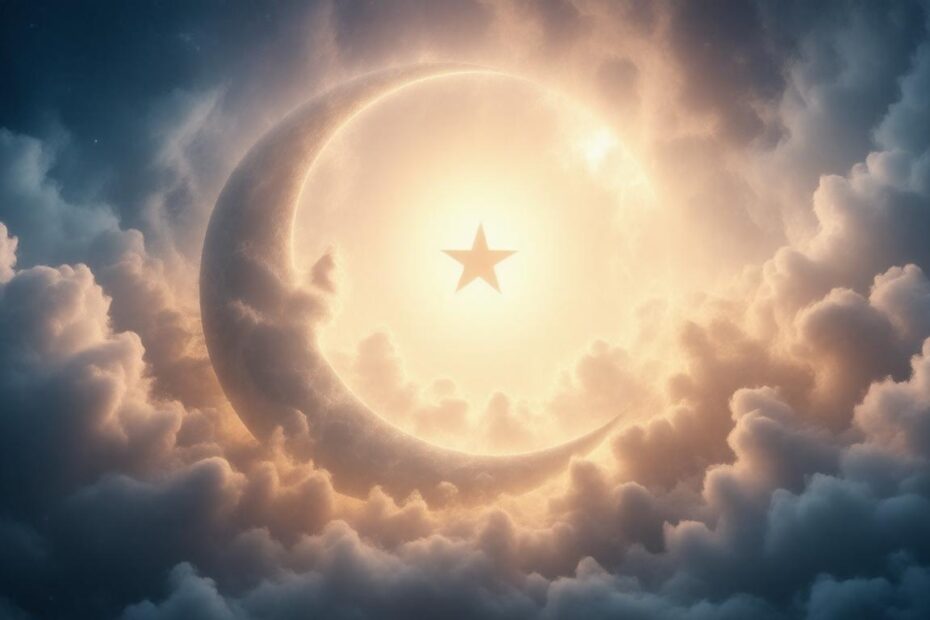🌟 Daily Awakening Quiz 🌟
The crescent moon and star symbol is one of the most recognizable and widely acknowledged emblems across various cultures, particularly in the Middle East and parts of North Africa. Beyond its aesthetic appeal, this symbol has a rich tapestry of spiritual meanings and significance that intertwine with the history, religion, and cultural practices of the regions where it is prevalent. In this exploration, we delve into the layers of meaning behind the crescent moon and star, as well as its implications for spirituality and daily life.
Historical Background
The origin of the crescent moon and star symbol can be traced back to several ancient cultures before it became prevalent in Islamic contexts. The symbol is believed to have been used in Byzantium around the first century BC as a representation of various divine entities, correlating the crescent with the moon and the star with Venus. This symbolic representation associated celestial bodies with everyday life, agriculture, and spiritual beliefs.
Throughout history, the crescent moon and star gained particular prominence as the emblem of the Ottoman Empire, where it became integrated into the flag and state emblem. After the dissolution of the empire, the crescent moon and star continued to be adopted by many nations that emerged across the Middle East and North Africa, thus establishing a modern identity linked to national pride and Islamic faith.
Spiritual Symbolism
1. Connection to Celestial Bodies
In spiritual practices, the moon holds lasting significance due to its cycles and rhythms, symbolizing fertility, femininity, and the passage of time. Specifically, the crescent moon represents new beginnings, intuition, and maternal energies. When viewed in conjunction with the star, interpretations often merge:
-
Crescent Moon: Represents growth, renewal, and potential. In various cosmologies, this phase of the moon embodies the female aspect, making it a powerful symbol of fertility and creativity.
-
Star: While various stars have different spiritual associations, the most notable in many cultures is Venus, synonymous with love, beauty, and guidance. The star often symbolizes hope, enlightenment, and navigation, signifying a guiding light in the darkness.
2. Reflection of Personal and Communal Identity
For many Muslims, the crescent moon and star have become emblematic of Islamic identity. They signify religious observances such as Ramadan, with the appearance of the crescent marking the beginning of the month of fasting. The Hilal, or crescent moon, is also a cherished icon in various Islamic cultures, reflecting a commitment to faith and community. The symbolism extends to communal gatherings, prayers, and celebrations, presenting a shared identity among diverse peoples.
3. Agricultural Calendar and Daily Life
Historically, the changes in the position of the moon and stars informed agricultural practices essential for survival and prosperity. The cycles of the moon were closely observed to determine the best times for sowing and harvesting crops. Stars, especially those such as Sirius and the Pleiades, acted as natural calendars for ancient farmers, tying their spiritual and daily exercises together. This connection reinforces the idea that one’s spiritual life is deeply intertwined with natural rhythms and sustenance.
Contemporary Interpretation
In modern contexts, the crescent moon and star continue to serve as significant cultural symbols beyond religion. They appear in art, jewelry, and flags, embodying values of unity, identity, and heritage. However, there is a complex discussion surrounding their interpretation in sovereign states and among different sects within Islam. Some embrace it as a symbol of Islamic faith and pride, while others view it with skepticism or as a misrepresentation of spiritual beliefs.
Conclusion
The crescent moon and star symbolize much more than just iconic imagery. They encapsulate astronomy, spirituality, culture, and identity, creating a multifaceted understanding that spans centuries and civilizations. To delve into this symbol is to engage with the cosmic, the earthly, and the communal, uncovering lessons about resilience, growth, and the cyclical nature of life itself. As we look to the sky and observe the moon and stars, we are reminded of the profound connections that shape our existence—both spiritually and materially.

